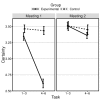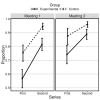Consequences of Learned Helplessness and Recognition of the State of Cognitive Exhaustion in Persons with Mild Intellectual Disability
- PMID: 28479937
- PMCID: PMC5413468
- DOI: 10.5709/acp-0205-6
Consequences of Learned Helplessness and Recognition of the State of Cognitive Exhaustion in Persons with Mild Intellectual Disability
Abstract
Persons with intellectual disability are a group at risk of being exposed to overly demanding problem-solving situations, which may produce learned helplessness. The research was based on the informational model of learned helplessness. The consequences of exposure to an unsolvable task and the ability to recognize the symptoms of cognitive exhaustion were tested in 120 students with mild intellectual disability. After the exposure to the unsolvable task, persons in the experimental group obtained lower results than the control group in the escape/avoidance learning task, but a similar result was found in the divergent thinking fluency task. Also, participants in the experimental group had difficulties recognizing the symptoms of the cognitive exhaustion state. After a week's time, the difference in escape/avoidance learning performance was still observed. The results indicate that exposure to unsolvable tasks may negatively influence the cognitive performance in persons with intellectual disability, although those persons may not identify the cognitive state related to lowered performance.
Keywords: avoidance learning; cognitive exhaustion; divergent thinking; fluency; intellectual disability; learned helplessness.
Figures




Similar articles
-
When cognitive exertion does not yield cognitive gain: toward an informational explanation of learned helplessness.J Pers Soc Psychol. 1990 Apr;58(4):729-43. doi: 10.1037//0022-3514.58.4.729. J Pers Soc Psychol. 1990. PMID: 2348367
-
Reactance and helplessness following exposure to unsolvable problems: the effects of attributional style.J Pers Soc Psychol. 1988 Apr;54(4):679-86. doi: 10.1037//0022-3514.54.4.679. J Pers Soc Psychol. 1988. PMID: 3367284
-
Learned helplessness: performance as a function of task significance.J Psychol. 1979 May;102(1st Half):77-82. doi: 10.1080/00223980.1979.9915097. J Psychol. 1979. PMID: 458750
-
Is there evidence of learned helplessness in horses?J Appl Anim Welf Sci. 2008;11(3):249-66. doi: 10.1080/10888700802101130. J Appl Anim Welf Sci. 2008. PMID: 18569222 Review.
-
Learned helplessness: unique features and translational value of a cognitive depression model.Cell Tissue Res. 2013 Oct;354(1):171-8. doi: 10.1007/s00441-013-1654-2. Epub 2013 Jun 13. Cell Tissue Res. 2013. PMID: 23760889 Review.
Cited by
-
Effects of School-Based Neurofeedback Training on Attention in Students with Autism and Intellectual Disabilities.J Autism Dev Disord. 2025 Aug;55(8):2884-2895. doi: 10.1007/s10803-024-06400-8. Epub 2024 May 28. J Autism Dev Disord. 2025. PMID: 38806749 Free PMC article.
-
Oligophrenin-1 moderates behavioral responses to stress by regulating parvalbumin interneuron activity in the medial prefrontal cortex.Neuron. 2021 May 19;109(10):1636-1656.e8. doi: 10.1016/j.neuron.2021.03.016. Epub 2021 Apr 7. Neuron. 2021. PMID: 33831348 Free PMC article.
References
-
- American Psychiatric Association . American Psychiatric Association: Diagnostic and statistical manual of mental disorders. 5th ed. Washington, DC: Author; 2013.
-
- Basil C. Social interaction and learned helplessness in severely disabled children. Augmentative and Alternative Communication. 1992;8:188–199.
-
- Benjamini Y., Yekutieli D. The control of the false discovery rate in multiple testing under dependency. The Annals of Statistics. 2001;29:1165–1188.
-
- Bukowski M., Asanowicz D., Marzecova A., Lupianez J. Limits of control: The effects of uncontrollability experiences on the efficiency of attentional control. Acta Psychologica. 2014;154:43–53. - PubMed
LinkOut - more resources
Full Text Sources
Other Literature Sources
